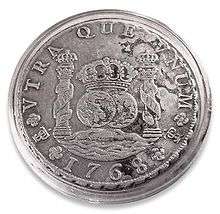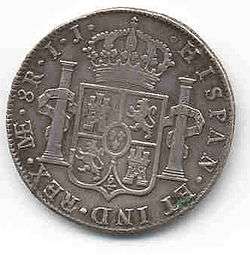Spanish real

The real (meaning: "royal", plural: reales) was a unit of currency in Spain for several centuries after the mid-14th century (see Spanish colonization of the Americas), but changed in value relative to other units introduced. In 1864, the real was replaced by a new escudo, then by the peseta in 1868, when a real came to mean a quarter of a peseta.
History


The first real was introduced by King Pedro I of Castile in the mid 14th century at a value of 3 maravedíes. This rate of exchange increased until 1497, when the real, now issued in billon, was fixed at a value of 34 maravedíes. The famous "piece of eight" (peso de a ocho), also known as the Spanish dollar, was issued that same year as a trade coin. It later became widespread in North America and Asia. In 1566, the gold escudo was introduced, worth 16 silver reales. The "piece of eight" was so-called because the denomination was divided into eight silver reales (8 reales = 1 silver peso). In addition to the "piece of eight," which was a one-ounce (28 g) silver coin, other coins based on it were issued: 4 reales, 2 reales, 1 real and the little (12 mm diameter) half real.
During this period, Spanish trade coinage became popular in international trade and commerce, and remained so for centuries.
17th century
In 1642, two distinct reales were created, the real de plata (made of silver) and the real de vellón (made of billon, or "less than half silver"). The exchange rate between these two coins was set at 2 reales de vellón = 1 real de plata. The maravedí was tied to the real de vellón, causing the real de plata to be worth 68 maravedíes. The gold escudo was worth 16 reales de plata. The real de vellón was issued for exclusive use in Spain and did not frequently circulate in the colonies.
18th century

The real de plata fuerte was introduced in 1737 at a value of 2 1⁄2 reales de vellón or 85 maravedíes. This real was the standard, issued as coins until the early 19th century. The gold escudo was worth 16 reales de plata fuerte.
19th century
In 1808, coins were introduced denominated in real de vellón. These coins circulated alongside real de plata fuerte and escudo coins until decimalization. Coins denominated in reales de plata were minted until 1837, whilst maravedí coins were issued until 1850.
Decimalization
The real de vellón, now just called the real, was adopted as the chief unit in Spain's first decimal currency, introduced in 1850. To begin with, subsidiary pieces were issued denominated in decima de real (tenths of a real). Later they were denominated in céntimo de real (hundredths of a real). The real replaced the Catalan peseta in 1850, at a rate of 1 peseta = 4 reales.
In 1864, the real was replaced by a new escudo worth 10 reales (i.e., not equivalent to the earlier escudo). This second escudo was itself replaced in 1868 by the peseta at a rate of 1 peseta = 0.4 escudos = 4 reales. Consequently, the term real lived on, meaning a quarter of a peseta.
Coins
Predecimal
In the 18th century, coins were issued in copper for 1, 2, 4 and 8 maravedíes, in silver for 1⁄2, 1, 2, 4 and 8 reales and in gold for 1⁄2, 1, 2, 4 and 8 escudos. The silver 8 reales coin was known as the Spanish dollar or peso (the famous "piece of eight"). Spanish dollars minted between 1732 and 1773 are also often referred to as columnarios. The portrait variety from 1772 and later are typically referred to as Spanish dollars or pillar dollars. There was also a denomination known as the peso sencillo worth 6 reales.
From 1808, coins were issued in denominations of 1/2, 1, 2, 4, and 8 reales.
Decimal
Copper coins were issued for 1⁄2, 1 and 2 decima de real and 1⁄2 real, with silver 1, 2, 4, 10 and 20 reales and gold 20, 40 and 100 reales. The new denominations were introduced between 1850 and 1853. In 1854, copper 5, 10 and 25 céntimos de reales were introduced.
See also
| Wikimedia Commons has media related to Real español. |
References
- Krause, Chester L.; Clifford Mishler (1991). Standard Catalog of World Coins: 1801–1991 (18th ed.). Krause Publications. ISBN 0873411501.
External links
- Coins from Guadalajara, Jalisco. Mexico (1812 - 2006) (gdlcoins.com)
- The Colonial Coinage of Spanish America: An introduction by Daniel Frank Sedwick